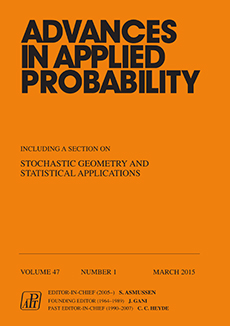Abstract
We consider a model of fixed size N = 2l in which there are l generations of daughter cells and a stem cell. In each generation i there are 2i-1 daughter cells. At each integral time unit the cells split so that the stem cell splits into a stem cell and generation 1 daughter cell and the generation i daughter cells become two cells of generation i+1. The last generation is removed from the population. A stem cell acquires first and second mutations at rates u1 and u2, and a daughter cell acquires first and second mutations at rates v1 and v2. We find the distribution for the time it takes to acquire two mutations as N goes to ∞ and the mutation rates go to 0. The mutation rates may tend to 0 at different speeds. We also find the distribution for the locations of the mutations. In particular, we determine whether or not the mutations occur on a stem cell and if not, at what generation in the daughter cells they occur. Several outcomes are possible, depending on how fast the rates go to 0. The model considered has been proposed by Komarova (2007) as a model for colon cancer.
Citation
Michael Kelly. "A hierarchical probability model of colon cancer." Adv. in Appl. Probab. 44 (4) 1052 - 1083, December 2012. https://doi.org/10.1239/aap/1354716589
Information





